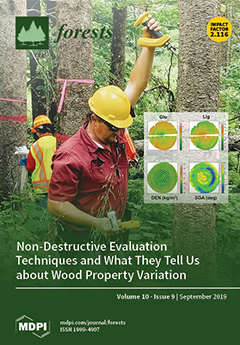Under current environmental changes, forest management is challenged to foster contrasting benefits from forests, such as continuous wood supply while preserving biomass production, biodiversity conservation, and contribution to climate change mitigation through atmospheric carbon sequestration. Although being found as globally important, estimates of
[...] Read more.
Under current environmental changes, forest management is challenged to foster contrasting benefits from forests, such as continuous wood supply while preserving biomass production, biodiversity conservation, and contribution to climate change mitigation through atmospheric carbon sequestration. Although being found as globally important, estimates of long-term forest C balance are still highly uncertain. In this context, the chronosequence experiments (space-for-time substitution) might fill this gap in even-aged forests, as they represent an approach that enables the assessment of forest net C balance in the long term. In this research, we explored the dynamics of C stocks and fluxes in different forest pools throughout the rotation period (140 years) of a Pedunculate oak (
Quercus robur L.) forest in Croatia. For this purpose, we selected a chronosequence that was made up of seven forest stands with different age (5, 13, 38, 53, 68, 108, and 138 years). To address the issues of uncertainty in C balance estimates, we compared net ecosystem carbon balance (NECB) estimated while using two different approaches, which we name pool-change (from C stocks) approach and component-flux (from C fluxes) approach. Overall, the pool-change approach showed higher NECB estimate, with the greatest difference being observed in younger stands (<50 years). Component-flux approach showed significantly higher uncertainty. Throughout the rotation period, managed pedunculate oak stands become a C sink early in their development phase, between the age of 13 and 35 years according to pool-change and component-flux approach, respectively. During the 140 years, oak forest provided 187.2 Mg C ha
−1 (604 m
3 ha
−1) through thinnings and 147.9 Mg C ha
−1 (477 m
3 ha
−1) in the final cut, while preserving, on average, 88.9 Mg C ha
−1 in mineral soil down to 40 cm, 18.2 Mg C ha
−1 in dead wood, and 6.0 Mg C ha
−1 in the forest floor. Soil C stocks in our chronosequence did not show any age-related trend, indicating that current management practice has no negative effect on soil C stocks. Finally, under current close-to-nature forest management, Pedunculate oak forest showed to be sustainable in providing both economic and ecological ecosystem services.
Full article





